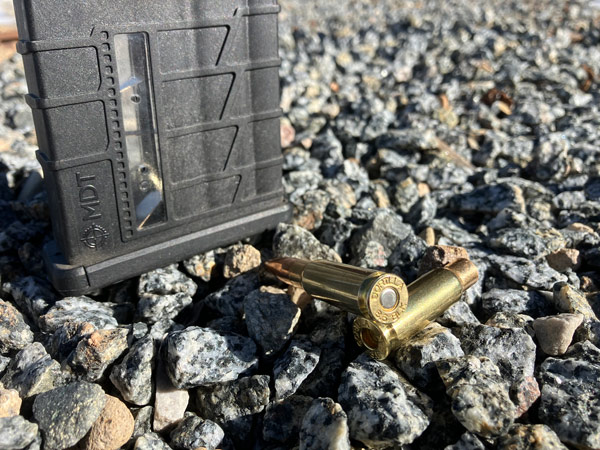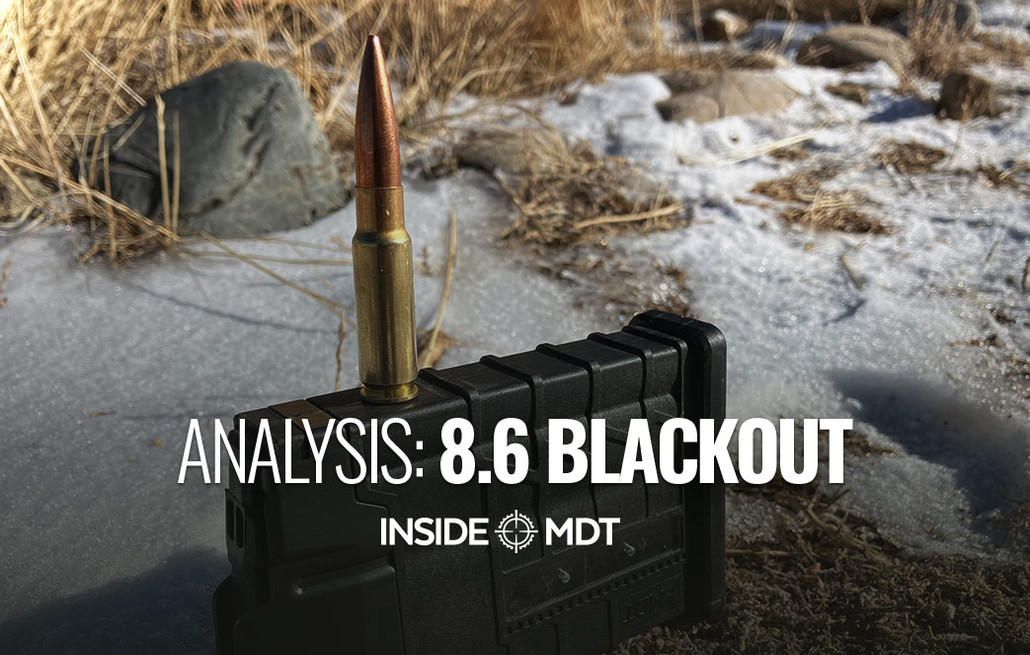Posted by Marcus Hom on 2024 Jan 2nd
Analysis: 8.6 Blackout - Inside MDT
It seems like every year, a new cartridge is released; some make sense and are a legitimate improvement over an old design, and others seem to be released for the sake of having something new. Ultimately, this is good for the industry because it gives manufacturers another chambering, which translates to increased sales and gives shooters a new cartridge to experiment with. Don't get me wrong; I don't want to sound like a Fudd. I'm not saying a guy only needs a 30-06. Still, I am saying many of the released cartridges offer little benefit to their predecessors, which is why I am skeptical when I hear about some "revolutionary" new cartridge offering.
8.6 BLACKOUT - 338 FEDERAL WITH A TWIST
Two years ago, I started hearing rumblings of a new "Blackout" cartridge. It would be the bigger brother to the 300 Blackout and be designed to run in semi-autos and sling heavy projectiles at subsonic speeds. This wasn't exactly a new idea. The 375 Raptor had already been out for around 5 years. I also talked with colleagues about loading the 338 Federal with heavy projectiles and shooting them at subsonic speeds. So, while this sounded like an interesting project, it certainly wasn't anything novel. That is how my opinion would have stayed, except for two facts: the cartridge designer was Kevin Brittingham of the newly formed company Q, and the other factor that piqued my interest was the 1:3 twist rate.
For those who don't geek out on internal ballistics, the twist rate is the amount of spin imparted onto the bullet by the barrel's rifling to stabilize it in flight. Think of throwing a tight spiral versus a wounded duck football pass. The twist rate is denoted by two numbers; the first is always the number one, meaning one full revolution. The second number represents how many inches the bullet travels down the barrel before its first full revolution. A smaller second number represents a tighter or faster twist. Traditionally, a 1 in 7 twist was considered very fast. This would be used on long, skinny projectiles that need more gyroscopic stability in flight. The new 8.6 Blackout would be spinning bullets twice that fast. Q claims this increased twist rate leads to better terminal performance through better bullet expansion and the "blender effect" of this bullet passing through and making 1 full revolution inside the animal every 3" it travels.
Beyond specifying a faster twist, the 8.6 Blackout utilizes the shorter parent case of Creedmoor vs Federal, using the .308 Win as its starting point. The shorter case allows for a more ideal bullet placement in the neck, with the bullet's boattail/bearing surface junction falling much closer to the neck/ shoulder junction. Given these interesting facts, I inevitably had to build a rifle and test this new cartridge.
BUILDING A BOLT ACTION 8.6 BLACKOUT
When I started my build, the barrel was the most difficult component to source, followed closely by brass. Barrel manufacturers producing .338 caliber barrels with a 1 in 3 twist rate were virtually nonexistent. Additionally, I did not want a pre-fit barrel; I needed a blank because I wanted to put my own spin on this project. Since the 8.6 blackout was designed primarily to be a subsonic cartridge, I wanted to try out a suppressor system I had seen at the SHOT show a few years earlier.

With some searching, I was able to find Aaron Crist of MOS-Tek. He could source an un-contoured barrel blank with the appropriate twist and fit and chamber it for my Mac Bros action. The chambered blank was then sent to Suppressed Weapon Systems (SWS) in Stafford, Texas. SWS had impressed me a few years earlier with their process of creating integrally suppressed rifle barrels out of uncontoured barrel blanks. As I intended to fire this new cartridge suppressed, the SWS treatment seemed like the perfect fit. Another benefit of SWS's offering is that since the suppressor and the barrel are one and the same, I did not have to get a tax stamp for a "short-barreled rifle" besides the suppressor.
On the Topic of barrel length: In precision shooting, barrel length can often be the shooter's friend, typically yielding an extra 25 feet per second (FPS) of muzzle velocity per inch of added barrel length. Who doesn't like free velocity, right? Folks trying to stay below 1100 FPS (the approximate speed of sound), that's who. So, 9 inches of rifling and an additional 9 inches of baffles was a perfect balance for my application.
I took my barreled action and dropped it into an ORYX pistol chassis. I affixed a folding stock, mounted a 1-8x Primary Arms scope on top of the action, and was off to the races. This setup is relatively lightweight, and with the stock folded, it is very packable.
RELOADING 8.6 BLACKOUT
At this point in the cartridge's development, reloading can be as simple or complicated as the handloader chooses to make it. Tinkerers are still forming their own brass from 6.5 Creedmoor cases, but for those such as myself with limited time, factory brass is available from Gorilla Ammunition. Projectiles are easy to come by, albeit expensive, as the .338 diameter has been used for a wide variety of cartridges. Primers are large rifle, and powders are similar to those used in the .300 Blackout.
For my testing, I could scrounge up a pound of Accurate 1680. This was the powder I saw most commonly referenced. This is not an article about handloading for wildcats. Still, you should always take what you read on the internet with a grain of salt and use your own experience and common sense. At least one recipe floating around that is 10 grains higher than what makes sense.

For testing I used brass from Gorilla Ammunition. 8.6 Blackout fed just fine through an MDT Short Action magazine.
I capped off 25 grains of AA1680 with a 225 gr Hornady CX and headed for my bench. Velocity from my 9" Mos-Tek barrel was just over 1600 feet per second. The brass extracted easily, and the case head showed no signs of pressure. Accuracy was certainly nothing to get excited about, with 3 separate charges, both shooting around 2-3 MOA. I am confident that I could cut that group size in half with some tuning. However, at over a dollar per projectile, I am not particularly interested in sending too many rounds into the berm to pursue tiny groups for a rifle that needs to hold a minute of deer out to 200 yards. During my shooting, I was able to hit a 12" plate at 300 yards with three consecutive rounds after a couple of sighters. My misses were extremely easy to spot, even at 300 yards through the 1-8, because of how much dirt those 225-grain .338 freedom seeds kicked up.
So what is the Point?
It isn't fast. It isn't the hardest-hitting, and at this point, with my handloads, it isn't even that accurate. All those things considered, this would still be the first rifle I would grab if I was still up in Alaska and headed out to put some late-season Sitka Blacktail venison in the freezer. I think of it as an updated version of the 30-30. It lays about 1,500 Ft/lbs of energy at the muzzle. With the relatively high ballistic coefficient bullets, it is only sloughing about 100 ft/lbs of energy per 100 yards. Laying down that much thump with so little noise and low recoil out of such a small package makes me smile. On top of that, because of the good sectional density and heavy bullets, I would not feel out of my league if a bear showed up.
The 8.6 Blackout isn't doing anything another cartridge couldn't. Still, when the 8.6 does it, it is quiet, with style, and in a compact, efficient package, and if I get increased lethality because of the uber-fast twist rate, I'll take that too.
CALIBER RESOURCES FROM MDT
- Analysis: 6.5 PRC
- Analysis: 6.5x47 and 6x47 Lapua
- The Carbon Ring
- Analysis: .277 Sig Fury - Inside MDT
- Is the 308 Winchester Still Relevant?
- Analysis: 6.5 Creedmoor
- Why All The Hate For The 30-06
- Loading 6MM ARC And .223 REMINGTON with A Dillon Progressive Press
- Hornady 6MM ARC For Competition
- Analysis: 6MM BR NORMA
- Fire Forming and Loading 223 AI
- Loading 6GT with Hodgdon H4350
- 270 Winchester and Colorado Elk
- 6mm GT Load Development
- Capable And Versatile: A Close Look at the 6.5X55 Swedish
- Analysis: .338 Lapua Magnum
- Analysis: 7MM PRC
- 280 AI: Merging Power and Precision
- 338 Lapua: A Journey
ABOUT THE AUTHOR
Marcus Hom is a shooter through and through. Born to a pistol-packing mama, he has spent his entire life around firearms. Marcus spent much of his adulthood guiding hunts in Alaska, teaching CCW and precision rifle courses, competing in national-level matches, conducting research and development, and gunsmithing. Marcus is a former Federal Law Enforcement Officer.


 CAD
CAD
 Euro
Euro
